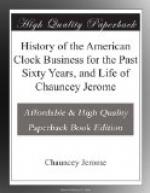began to make them. I will say here a little
more about human nature and what I have seen and experienced.
during the last forty-five years. Let an ingenious,
thinking man invent something that looks favorable
for making money, and one after another will be stealing
into the same business, when they know their conduct
is very mean towards the originator who may be one
of the best men in the community; still, nine out
of ten of those who are infringing on his improvement
will begin to hate and abuse him. I have seen
this disposition carried out all my life-time.
Forty-five years ago, Mr. Eli Terry was the great
man in the wood clock business. As I have said
before, he got up the Patent Wood Shelf Clock and sold
a right to make it to Seth Thomas for one thousand
dollars. After two or three years, Mr. Terry
made further improvements and got them patented.
Mr. Thomas then thought as he had paid a thousand
dollars, he would use these improvements; so he went
on making the new patent. Mr. Terry sued him
and the case was in litigation for several years.
The whole Thomas family, the workmen and neighbors,
felt envious towards Mr. Terry, and I think they have
never got entirely over it. There was a general
prejudice and hatred towards Mr. Terry amongst all
the clock-makers at that time, and for nothing only
because they knew they were infringing on his rights;
and to act out human nature, they must slander and
try to put him down. This principle is carried
out very extensively in this world, so that if a man
wants to live and have nothing said against him, he
must look out for, and help no one but himself.
If he succeeds in making money, it matters but little
in what way he obtains it, whether by gambling or
any other unlawful means; while on the other hand,
if he has been doing good all his life, and by some
mishap is reduced to poverty in his old age, he is
despised and treated with contempt by a majority of
the community.
It may not be uninteresting to a great many to know
how the brass clocks at the present day are made.
It has been a wonder to the world for a long time,
how they could possibly be sold so cheap and yet answer
so good a purpose. And, indeed, they could not,
if every part of their manufacture was not systematized
in the most perfect manner and conducted on a large
scale. I will describe the manner in which the
O-G. case is made, (the style has been made a long
time, and in larger numbers than any other,) which
will give some idea with what facility the whole thing
is put through. Common merchantable pine lumber
is used for the body of the case. The first workman
draws a board of the stuff on a frame and by a movable
circular saw cuts it in proper lengths for the sides
and top. The knotty portions of it are sawed in
lengths suitable for boxing the clocks when finished,
and but little need be wasted. The good pieces
are then taken to another saw and split up in proper
widths, which are then passed through the planeing




